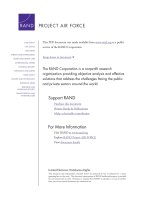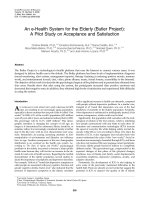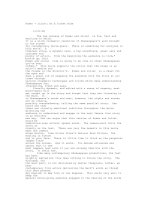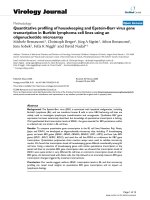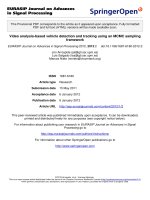ESL podcast 899 purchasing and using an e ticket
Bạn đang xem bản rút gọn của tài liệu. Xem và tải ngay bản đầy đủ của tài liệu tại đây (94.86 KB, 9 trang )
English as a Second Language Podcast
www.eslpod.com
ESL Podcast 899 – Purchasing and Using an E-Ticket
GLOSSARY
to check in – to officially present oneself at an event or location; to sign in and
register for something
* When you arrive for your interview, please check in at the front desk and then
take a seat in the waiting area.
e-ticket – an electronic ticket; a ticket that is available on a website or by email,
but not physically mailed to the buyer
* Can I get on the train just by showing this e-ticket on my smart phone, or do I
need to bring a printed copy?
to go onto [a website] – to visit a website; to go to a URL
* Tessor goes onto this bank’s website at least once a week to check his account
for any fraudulent transactions.
screen – the part of a computer, television, or other electronic device that
displays information in lights
* The screen on this phone is almost impossible to read in the sunlight.
to prompt (someone) – to cue someone to do something; to give a signal or
make a request indicating that a person needs to do something
* Walking by a flower shop prompted Nolan to buy flowers for his girlfriend.
confirmation receipt – an electronic or digital document that provides proof that
a payment has been made, a request has been received, a transaction has been
processed, or some other action has been taken
* Please print out this confirmation receipt for your records.
ticket number – a unique number found on a ticket, used to identify the
purchase and the person to whom it belongs
* Please type in your ticket number and your last name, and our computer should
be able to retrieve your payment history.
itinerary – a travel plan; a list of all the important flights, train trips, bus rides,
hotels, and other items used to coordinate travel on a trip
* The executive assistant is responsible for coordinating the CEO’s itineraries.
to print out – to have a computer produce a printed version (on paper) of an
electronic document or image
* We have thousands of digital photographs on the computer, but we rarely print
them out.
1
These materials are copyrighted by the Center for Educational Development (2013). Posting of
these materials on another website or distributing them in any way is prohibited.
English as a Second Language Podcast
www.eslpod.com
ESL Podcast 899 – Purchasing and Using an E-Ticket
to go up to – to approach; to move closer to someone or something
* The elderly, the disabled, and pregnant women are allowed to go up to the front
of the line.
self-serve kiosk – a computer where people can complete their transaction
without needing assistance from an employee and without interacting with a
person
* Utility customers can pay their bills by mail, in person, or at a self-serve kiosk.
to swipe – to move something very quickly, especially to slide a credit or debit
card into the side of a plastic machine that “reads” the information and then
completes a transaction
* Pedro tried to swipe his debit card at the grocery store, but it didn’t work, so the
grocery clerk had to enter his card number by hand.
to bring up – to retrieve information and have it be displayed on a computer
screen
* Let me bring up the current version of the report so we can edit it together.
to flag down – to wave one’s hand or arm in the air to get someone’s attention
and have that person come closer and provide assistance
* Please flag down the waiter and ask him to bring some more napkins.
check-in counter – a large desk at an airport where many employees help
passengers get their boarding passes or tickets and check their luggage
* The woman at the check-in counter said that our bags were too heavy, so we
had to pay an extra fee.
boarding pass – a printed document that allows a passenger to get on an
airplane
* Li thought she had lost her boarding pass, but found it before her flight.
glitch – a technical problem, especially a computer error
* We’re sorry, but there was a glitch when you tried to pay your bill online. We
have fixed the problem, so please try again.
the best laid plans of mice and men often go awry – a phase based on a
Robert Burns’ poem “To a Mouse,” meaning that no matter how much we plan for
things, what actually happens is unpredictable and beyond our control
* They wanted to have an outdoor wedding, but then a hurricane passed through.
The best laid plans of mice and men often go awry.
2
These materials are copyrighted by the Center for Educational Development (2013). Posting of
these materials on another website or distributing them in any way is prohibited.
English as a Second Language Podcast
www.eslpod.com
ESL Podcast 899 – Purchasing and Using an E-Ticket
COMPREHENSION QUESTIONS
1. Which document would he need to present immediately before getting on the
airplane?
a) His e-ticket.
b) His confirmation receipt.
c) His boarding pass.
2.
a)
b)
c)
What did he do when he “flagged down an employee”?
He yelled at the employee.
He asked to speak to the manager.
He got the employee’s attention.
______________
WHAT ELSE DOES IT MEAN?
to prompt
The verb “to prompt,” in this podcast, means to cue someone to do something, or
to give a signal or make a request indicating that a person needs to do
something: “Howard uses a special alarm on his computer to prompt him to stand
up and go for a short walk every hour.” The verb “to prompt” also means to make
someone want to do something: “What prompted you to study architecture?” In
acting, “to prompt” means to remind an actor of what he or she is supposed to
say next: “Don’t worry, if you forget your line. The director will prompt you.” As an
adjective, “prompt” means quickly, soon, or at the right time: “Thank you for your
prompt reply.” Or, “Please arrive promptly as we will not wait for anyone who
arrives late.”
to flag down
In this podcast, the phrase “to flag down” means to wave one’s hand or arm in
the air to get someone’s attention and have that person come closer and provide
assistance: “The policeman flagged down passing cars and asked to see the
drivers’ license.” The verb “to flag” means to make a mark or put a piece of paper
next to important parts of a document: “We’ve flagged a few typos in the report.”
Finally, the phrase “to wave the white flag” means to surrender or to show that
one no longer wants to fight: “When the enemy began to wave the white flag, all
our soldiers began cheering.” Finally, the phrase “like a red flag to a bull”
describes doing something to make another person angry: “When we see
Jeremiah tonight, please don’t talk about what happened. That would be like a
red flag to a bull.”
3
These materials are copyrighted by the Center for Educational Development (2013). Posting of
these materials on another website or distributing them in any way is prohibited.
English as a Second Language Podcast
www.eslpod.com
ESL Podcast 899 – Purchasing and Using an E-Ticket
CULTURE NOTE
Of Mice and Men
Of Mice and Men is a 1937 novel by John Steinbeck. It is about two “migrant
workers” (people who move from place to place while looking for work, especially
doing farm work) who are looking for jobs in California during the “Great
Depression” (very difficult economic times before World War II). The title of the
novel was “taken” (adapted; borrowed) from a poem called “To a Mouse” by
Robert Burns.
The novel is about two men, George and Lennie. Lennie is very big and strong,
but he has some “mental problems” (slow or incomplete intellectual and/or
emotional development). They are very good friends, and George often protects
Lennie. Lennie often gets into trouble, because he does not understand what he
is doing or how his actions are “perceived” (observed and interpreted) by others.
The men dream of owning a “ranch” (a large farm that raises many large animals
like cows and horses), but they face many “obstacles” (things that make it difficult
for one to achieve goals). In the end, Lennie becomes the “pair’s” (the two men’s)
greatest obstacle to fulfilling their dream, but you’ll have to read the novel to
understand why – no “spoilers” (something that tells a person how a book or
movie ends and ruins the story) here!
The novel is often “required reading” (something that all students must read) in
American high schools, but it has also been a “target of censorship” (something
that people do not want to have be made available, usually because they believe
it is wrong) it has some offensive and “racist” (treating people unfairly based on
the color of their skin) language.
______________
Comprehension Questions Correct Answers: 1 – c; 2 – c
4
These materials are copyrighted by the Center for Educational Development (2013). Posting of
these materials on another website or distributing them in any way is prohibited.
English as a Second Language Podcast
www.eslpod.com
ESL Podcast 899 – Purchasing and Using an E-Ticket
COMPLETE TRANSCRIPT
Welcome to English as a Second Language Podcast number 899 – Purchasing
and Using an E-Ticket.
This is English as a Second Language Podcast episode 899. I'm your host, Dr.
Jeff McQuillan, coming to you from the Center for Educational Development in
beautiful Los Angeles, California.
Our website is ESLPod.com. Become a member of ESL Podcast by going to our
website.
This episode is a story about using an electronic ticket to travel. Let’s get started.
[start of story]
I thought I would save time by purchasing my airline ticket online and checking in
at the airport with my e-ticket. I went onto the McQ Air website and selected my
flights. The screen then prompted me to pay with a credit card. After I typed in
my payment information, I got a confirmation receipt with my ticket number and
my itinerary. I printed out a copy of my e-ticket and I was ready to go – easy!
But when I got to the airport, it was a different story. I went up to a self-serve
kiosk and swiped my credit card to bring up my account. The computer said that
it couldn’t find my account. I flagged down an employee and she didn’t have any
better luck, suggesting I stand in line at the check-in counter.
I got in the long line and 45 minutes later, the employee helped me check in and
gave me my boarding pass. When I asked her what the problem was, she said
she didn’t know and it was probably just a glitch in their computer system.
Well, the best laid plans of mice and men often go awry, especially if technology
is involved!
[end of story]
Our story begins by me saying, “I thought I would save time by purchasing my
airline ticket online.” “To save time” means to do something more quickly so that
it won't take as much time. I decided I would save time by purchasing – buying –
my airline ticket online – on the Internet – and checking in at the airport with my
e-ticket. “To check in” is a two-word phrasal verb, meaning usually to present
yourself at an event or at a location to register for something. When we use it in
5
These materials are copyrighted by the Center for Educational Development (2013). Posting of
these materials on another website or distributing them in any way is prohibited.
English as a Second Language Podcast
www.eslpod.com
ESL Podcast 899 – Purchasing and Using an E-Ticket
terms of airline travel, we mean to go to the airport and to tell the airline, “Yes, I'm
here. I want to get on the airplane.” You have to check in before you're allowed to
go onto an airplane.
I said I was going to check in at the airport with my e-ticket. “E-ticket” stands for
electronic ticket. It's a ticket that most airlines in the United States now use. It's
not a paper ticket that they send you like they used to many years ago. I still
remember those days. Instead, they just send you an e-mail or they take you to a
website. Now, you can print out your e-mail but that's not exactly the same as a
paper ticket. An e-ticket is something that's done electronically and most tickets
nowadays are e-tickets. I say that, “I went on to the McQ Air website.” “To go on
to a website” means to visit a website, to go to that URL, that address on your
web browser on your computer or your phone. I went onto the McQ Air website
and selected, or picked, chose, my flights.
A “screen” is anything on an electronic device that is used to display something,
to look at something. A “screen” could also be something that's on a wall that you
show a movie on. In talking about computers though, the screen is a thing you're
looking at. It could be a separate monitor from your main part of your computer,
or it could be, for example, on a smart phone such as an iPhone. It could be the
part of the phone that you look at that, that the information is displayed on. In our
story, “screen” really means the same as the page that was on the screen.
“The screen prompted me to pay with a credit card.” “To prompt (prompt)
someone” means to tell them they should do a certain action, to give them an
indication that they should do something, to request that they do something. So,
the website is prompting me – is asking me, if you will – to pay with a credit card.
After I typed in my payment information -- my name, my credit card number, and
so forth – I got a confirmation receipt with my ticket number and my itinerary.
A “confirmation receipt” is an electronic, in this case, document that shows that
you have paid for something. You can print it out and show someone and say,
“Look, I paid for this. I have a confirmation receipt.” A “receipt” in general, is any
piece of paper or e-mail that indicates that you have purchased something.
“Confirmation” is used here because we’re talking about making an airline
reservation and when you make a reservation, when you say, “Yes, I want to fly
on this day at this time,” the airline says back to you, “Yes. Okay. You can do
that.” They give you a confirmation of your reservation.
I say that, “I got a confirmation receipt with my ticket number and my itinerary.”
Your “ticket number” is a number that is on your ticket that is used to identify that
ticket and that ticket only. Every ticket has its own ticket number. “Itinerary”
6
These materials are copyrighted by the Center for Educational Development (2013). Posting of
these materials on another website or distributing them in any way is prohibited.
English as a Second Language Podcast
www.eslpod.com
ESL Podcast 899 – Purchasing and Using an E-Ticket
(itinerary) means your travel plans. An “itinerary” is a list of all the important, in
this case, airline flights that you are going to take. Your complete itinerary might
include the airline flights you're going to take, the hotels you’re going to stay at,
the tours that you may take – all that could be part of your itinerary.
Sometimes people use the word “itinerary” to mean their travel schedule,
everything they will be doing when they are traveling. Next, I say, “I printed out a
copy of my e-ticket and I was ready to go.” “To print out” means to make a paper
copy of your electronic ticket. This, of course, is kind of funny because the idea is
that you would be saving paper, not using paper, by having an electronic ticket,
but the truth is most of us know that computers don't always work the way they
should. And so we print out a copy so we have proof that we did what we said we
did, in this case, that we purchased a ticket.
I say that, “When I got to the airport, it was a different story,” meaning things did
not go the way I planned them to go. I say, “I went up to a self service kiosk and
swiped my credit card to bring up my account.” Lots of vocabulary in that
sentence, let's take a look. “I went up to” means I walked up to. I walked in the
direction of and then stopped in front of something. You could go up to a person,
or you could go up to, in this case, an object. The object that the person is going
up to, is walking up to, is a self-serve kiosk. “Self-serve” means there isn't
anyone there to help you. You are doing everything yourself. You are serving or
helping yourself.
A “kiosk” (kiosk), in American English, usually refers to a computer where people
can go and get information, or buy things, without anyone helping them. In other
countries, in other languages, “kiosk” means a little, something a little different,
but when we talk about a “self-serve kiosk,” we’re talking about a computer or a
machine that you can go and do things on. This kiosk asked me to swipe my
credit card.
“To swipe” (swipe) means to move something very quickly, especially a credit
card or any other sort of bankcard through a machine that reads the electronic
information on the card. When you go to a store, there'll often be a little machine
and you use that machine to put your credit card information into the electronic
system of the store. You do that by moving the credit card very quickly through
the machine. The verb we use specifically for that action is “swipe.”
So, I swiped my credit card to bring up my account. “To bring up” is a two-word
phrasal verb that has a couple of different meanings. Here, it means to retrieve or
get information from a computer and have it be displayed on the computer
screen. “To bring up” can also mean to raise a child, to be a parent and/or a
7
These materials are copyrighted by the Center for Educational Development (2013). Posting of
these materials on another website or distributing them in any way is prohibited.
English as a Second Language Podcast
www.eslpod.com
ESL Podcast 899 – Purchasing and Using an E-Ticket
friend who helps a child grow up, but here it means simply to get information from
the computer so you can see it. The computer, however, said that it couldn't find
my account. “My account” here would be my information. “I then flagged down an
employee.” “To flag (flag) down” is a two-word phrasal verb meaning, usually, to
wave your hand in the air in order to get someone's attention, to get them to
come over and help you. We can flag down an employee at an airport and ask
them to help us.
That's what I'm doing in the story. You could also flag down someone else who
you want to help you in some public space. You may flag down a police officer if
you have a problem and you need his help or her help. I flagged down an
employee but she didn't have any better luck, meaning she wasn't able to find the
information either. “So, she suggested that I stand in line at the check-in
counter.” “To stand in line” means to go and to wait for someone to help you. The
“check-in counter” is the place, usually a very large desk at an airport where
employees will help you check in. It's different than the self-service kiosk where
you're supposed to check-in yourself. The check-in counter is the place where
they have real live human beings that will help you.
“I got in the long line and 45 minutes later, the employee helped me check in and
gave me my boarding pass.” A “boarding pass” is a – usually a small piece of
paper that you're given that you have to give to the airline employee in order to
get on the actual plane. So, you hold it. You keep it with you. It also proves that
you are going to go on an airplane and is your only way, typically, to get past the
airport security. Now, in most American airports, you can't go up into where the
people are getting on airplanes unless you have a boarding pass, unless you are
actually traveling. In the old days, you could just go up to any airport and go
through the security and sit and wait for someone to leave or for someone to
arrive. Nowadays, you can't do that. You have to have a boarding pass to get
past security. I asked the person what the problem was – why the computer
couldn't find my information and I was told it was just a glitch in their computer
system.
A “glitch” (glitch) is a technical problem, usually a small problem related to the
way the computer is working. It's not working correctly. It's an error. I end by
saying that, “The best laid plans of mice and men often go awry.” This is an old
expression that means even when we plan things very carefully, sometimes
things happen and our plan does not work out. Our plan is not successful. “The
best laid plans” would be the plans that are prepared the best. Even if we
prepare good plans, they often go awry. “To go awry” (awry) means to go wrong.
There is a famous book in English called Of Mice and Men. You can learn about
that in our Learning Guide.
8
These materials are copyrighted by the Center for Educational Development (2013). Posting of
these materials on another website or distributing them in any way is prohibited.
English as a Second Language Podcast
www.eslpod.com
ESL Podcast 899 – Purchasing and Using an E-Ticket
Now let’s listen to the story, this time at a normal speed.
[start of story]
I thought I would save time by purchasing my airline ticket online and checking in
at the airport with my e-ticket. I went onto the McQ Air website and selected my
flights. The screen then prompted me to pay with a credit card. After I typed in
my payment information, I got a confirmation receipt with my ticket number and
my itinerary. I printed out a copy of my e-ticket and I was ready to go – easy!
But when I got to the airport, it was a different story. I went up to a self-serve
kiosk and swiped my credit card to bring up my account. The computer said that
it couldn’t find my account. I flagged down an employee and she didn’t have any
better luck, suggesting I stand in line at the check-in counter.
I got in the long line and 45 minutes later, the employee helped me check in and
gave me my boarding pass. When I asked her what the problem was, she said
she didn’t know and it was probably just a glitch in their computer system.
Well, the best laid plans of mice and men often go awry, especially if technology
is involved!
[end of story]
You can go on to our website and print out the wonderful scripts by our wonderful
scriptwriter, Dr. Lucy Tse.
From Los Angeles, California, I'm Jeff McQuillan. Thank you for listening. Come
back and listen to us again, right here on ESL Podcast.
English as a Second Language Podcast was written and produced by Dr. Lucy
Tse, hosted by Dr. Jeff McQuillan. Copyright 2013 by the Center for Educational
Development.
9
These materials are copyrighted by the Center for Educational Development (2013). Posting of
these materials on another website or distributing them in any way is prohibited.

